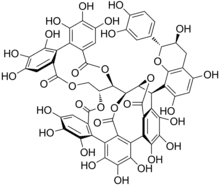 | |
| Identifiers | |
|---|---|
3D model (JSmol) |
|
| ChemSpider | |
PubChem CID |
|
| |
| |
| Properties | |
| C56H38O31 | |
| Molar mass | 1206.88 g/mol |
Except where otherwise noted, data are given for materials in their standard state (at 25 °C [77 °F], 100 kPa).
Infobox references | |
Acutissimin A is a flavono-ellagitannin, a type of tannin formed from the linking of a flavonoid with an ellagitannin.
In 2003, scientists at Institut Européen de Chimie et Biologie in Pessac, France found that when the oak tannin vescalagin interacts with a flavanoid in wine acutissimin A is created. In separate studies this phenolic compound has been shown to be 250 times more effective than the pharmaceutical drug Etoposide in stopping the growth of cancerous tumors.[1][2][3]
See also
References
- ↑ Quideau S, Jourdes M, Saucier C, Glories Y, Pardon P, Baudry C (December 2003). "DNA topoisomerase inhibitor acutissimin a and other flavano-ellagitannins in red wine". Angewandte Chemie. 42 (48): 6012–4. doi:10.1002/anie.200352089. PMID 14679557.
- ↑ Kashiwada Y, Nonaka G, Nishioka I, Chang JJ, Lee KH (August 1992). "Antitumor agents, 129. Tannins and related compounds as selective cytotoxic agents". Journal of Natural Products. 55 (8): 1033–43. doi:10.1021/np50086a002. PMID 1431932.
- ↑ Quideau, StéPhane; Jourdes, Michael; Saucier, Cédric; Glories, Yves; Pardon, Patrick; Baudry, Christian (2003). "DNA Topoisomerase Inhibitor Acutissimin A and Other Flavano-Ellagitannins in Red Wine". Angewandte Chemie. 115 (48): 6194–6. doi:10.1002/ange.200352089.
While it would be quite inappropriate to infer from the presence of acutissimin A in red wine that this beverage possesses antitumor properties, our work shows for the first time that wine contains polyphenolic molecules displaying both ellagitannin and flavanoid structural features.
This article is issued from Wikipedia. The text is licensed under Creative Commons - Attribution - Sharealike. Additional terms may apply for the media files.